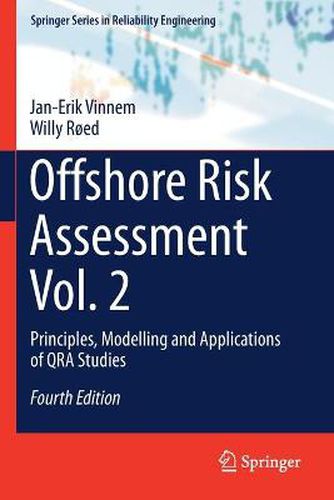Readings Newsletter
Become a Readings Member to make your shopping experience even easier.
Sign in or sign up for free!
You’re not far away from qualifying for FREE standard shipping within Australia
You’ve qualified for FREE standard shipping within Australia
The cart is loading…






This title is printed to order. This book may have been self-published. If so, we cannot guarantee the quality of the content. In the main most books will have gone through the editing process however some may not. We therefore suggest that you be aware of this before ordering this book. If in doubt check either the author or publisher’s details as we are unable to accept any returns unless they are faulty. Please contact us if you have any questions.
This is the first textbook to address quantified risk assessment (QRA) as specifically applied to offshore installations and operations. As the second part of the two-volume updated and expanded fourth edition, it adds a new focus on the recent development of Normally Unattended Installations (NUIs), which are essentially autonomous installations that combine digitalization, big data, drones and machine learning, and can be supported by W2W (walk-to-work) vessels. These minimalistic installations with no helideck and very limited safety systems will require a new approach to risk assessment and emergency planning, especially during manned periods involving W2W vessels.
Separate chapters analyse the main hazards for offshore structures: fire, explosion, collision, and falling objects, as well as structural and marine hazards. The book explores possible simplifications of risk assessment for traditional manned installations. Risk mitigation and control are also discussed, as well as how the results of quantitative risk assessment studies should be presented. In closing, the book provides an updated approach to environmental risk assessment.
The book offers a comprehensive reference guide for academics and students of marine/offshore risk assessment and management. It will also be of interest to professionals in the industry, as well as contractors, suppliers, consultants and regulatory authorities.
$9.00 standard shipping within Australia
FREE standard shipping within Australia for orders over $100.00
Express & International shipping calculated at checkout
This title is printed to order. This book may have been self-published. If so, we cannot guarantee the quality of the content. In the main most books will have gone through the editing process however some may not. We therefore suggest that you be aware of this before ordering this book. If in doubt check either the author or publisher’s details as we are unable to accept any returns unless they are faulty. Please contact us if you have any questions.
This is the first textbook to address quantified risk assessment (QRA) as specifically applied to offshore installations and operations. As the second part of the two-volume updated and expanded fourth edition, it adds a new focus on the recent development of Normally Unattended Installations (NUIs), which are essentially autonomous installations that combine digitalization, big data, drones and machine learning, and can be supported by W2W (walk-to-work) vessels. These minimalistic installations with no helideck and very limited safety systems will require a new approach to risk assessment and emergency planning, especially during manned periods involving W2W vessels.
Separate chapters analyse the main hazards for offshore structures: fire, explosion, collision, and falling objects, as well as structural and marine hazards. The book explores possible simplifications of risk assessment for traditional manned installations. Risk mitigation and control are also discussed, as well as how the results of quantitative risk assessment studies should be presented. In closing, the book provides an updated approach to environmental risk assessment.
The book offers a comprehensive reference guide for academics and students of marine/offshore risk assessment and management. It will also be of interest to professionals in the industry, as well as contractors, suppliers, consultants and regulatory authorities.